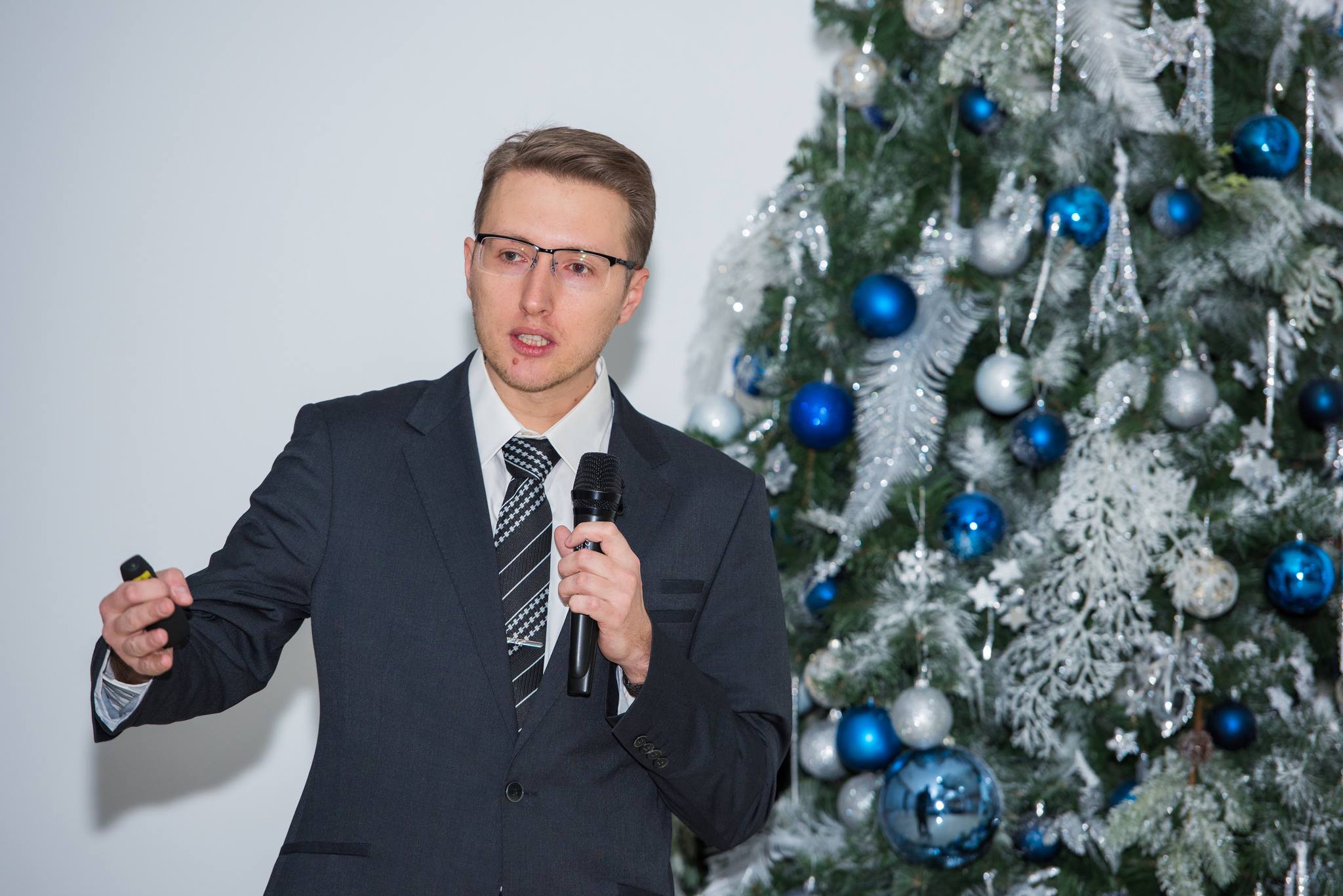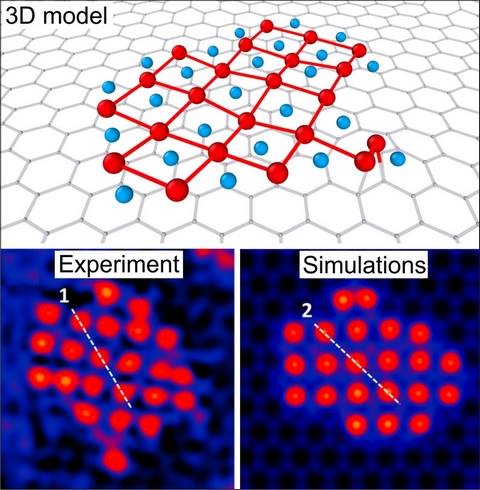Experimentally confirmed the birth of a new family of substances or Square daughter of graphene
For the first time in the world, an experimentally obtained representative of a new family of two-dimensional substances is copper oxide. He has already demonstrated to his creators several unusual properties that can not only expand the field for experiments with graphene, but also set a new direction in microelectronics. An article about the achievement of scientists from the National Science and Technology University "MISiS", FSBI TISNUM, IBCS RAS and their foreign colleagues from the Japanese Institute NIMS was published in the authoritative journal NanoScale. Read it here .
An international group of physicists predicted and experimentally confirmed the existence of a new family of inorganic compounds. As the head of the theoretical part of the work, the head of the infrastructure project “Theoretical Materials Science of Nanostructures”, the leading researcher of the laboratory “Inorganic Nanomaterials” NIT “MISiS” Dr. Sc. Pavel Borisovich Sorokin, we are talking about the world's first two-dimensional material with a square crystal lattice - copper oxide.

')
Pavel Sorokin (center) at the Scopus Award Russia-2015 award ceremony
Creation of new two-dimensional materials - materials consisting of a layer one atom thick - one of the most promising areas of modern materials science. Since receiving in 2004, graphene - the first two-dimensional material - scientists around the world are exploring its features, trying to combine it with other materials to obtain new properties.
The researchers conducted a synthesis of a new family of substances by studying various properties of graphene. Therefore, the islands of two-dimensional copper oxide are located on a graphene basis. According to Dr. Sorokin, synthesis on a graphene substrate is the only real possibility to obtain these two-dimensional materials. However, given the development of technology, this limitation is quite surmountable, the scientist emphasized.

At the “Christmas Lectures” at NUST “MISiS”, Dr. Sorokin gives a lecture “There is a lot of space down there, and there is a lot of interesting things in this place. News two-dimensional world. "
Unlike graphene, which is formed by hexagonal honeycombs, two-dimensional copper oxide has a square crystal lattice. “Until now, scientists were able to synthesize only materials with a hexagonal lattice - for example, various graphene derivatives or boron nitride,” says Dr. Sorokin. “The flat square metal lattice is unstable, but the combination of copper with oxygen stabilized it.”
The method used opens up broad possibilities for the synthesis of a new family of materials. ” In fact, scientists managed to achieve a “self-assembly” of two-dimensional copper oxide for graphene. In order to create a new substance, experimenters from the NIMS Institute (Japan) besieged copper atoms from the gas phase on partially oxidized graphene. Then the heating of the system led to the fact that the oxygen and copper atoms regrouped in a new structure.

All the features of the new material will have to be studied for a long time, however, something about the properties of two-dimensional copper oxide can be said now. One of the unusual properties of the new material predicted by Russian physicists Pavel Sorokin and Dmitry Kvashnin was antiferromagnetism (low magnetization), which ordinary copper oxide does not exhibit under any conditions.
Antiferromagnetics are very promising materials from the point of view of microelectronics. To write one bit of information into an antiferromagnet, just 12 atoms of its surface are enough, while existing technologies use hundreds of thousands of atoms to write one bit.
There is another consequence of the new experiment. “Our discovery has shown the possibility of a new use of graphene as the basis for the assembly of various substances,” says Dr. Sorokin. - Moreover, not only independent individual materials, but also multilayer two-dimensional heterostructures. In the present experiment on graphene, a new monolayer structure was formed, possessing only a set of inherent properties that we still have to study in detail. ”
Help NITU "MISIS": Pavel Borisovich Sorokin, doctor of physical and mathematical sciences. Head of the infrastructure project "Theoretical Materials Science of Nanostructures" in NITU "MISiS", leading researcher of the laboratory "Inorganic Nanomaterials".
Research interests: atomistic modeling, nanostructures, nanotechnology, quantum-chemical calculations from first principles, density functional theory, empirical methods of calculation.
The Prize of the Russian Club of the European Academy (Academia Europaea) for young scientists in the field of physics, the Scopus Award Russia-2015. Over 60 publications in international journals, including Nature Physics, Nature Communications, Nano Letters, ACS Nano, J. Phys. Chem. Lett. other.
An international group of physicists predicted and experimentally confirmed the existence of a new family of inorganic compounds. As the head of the theoretical part of the work, the head of the infrastructure project “Theoretical Materials Science of Nanostructures”, the leading researcher of the laboratory “Inorganic Nanomaterials” NIT “MISiS” Dr. Sc. Pavel Borisovich Sorokin, we are talking about the world's first two-dimensional material with a square crystal lattice - copper oxide.

')
Pavel Sorokin (center) at the Scopus Award Russia-2015 award ceremony
Creation of new two-dimensional materials - materials consisting of a layer one atom thick - one of the most promising areas of modern materials science. Since receiving in 2004, graphene - the first two-dimensional material - scientists around the world are exploring its features, trying to combine it with other materials to obtain new properties.
The researchers conducted a synthesis of a new family of substances by studying various properties of graphene. Therefore, the islands of two-dimensional copper oxide are located on a graphene basis. According to Dr. Sorokin, synthesis on a graphene substrate is the only real possibility to obtain these two-dimensional materials. However, given the development of technology, this limitation is quite surmountable, the scientist emphasized.

At the “Christmas Lectures” at NUST “MISiS”, Dr. Sorokin gives a lecture “There is a lot of space down there, and there is a lot of interesting things in this place. News two-dimensional world. "
Unlike graphene, which is formed by hexagonal honeycombs, two-dimensional copper oxide has a square crystal lattice. “Until now, scientists were able to synthesize only materials with a hexagonal lattice - for example, various graphene derivatives or boron nitride,” says Dr. Sorokin. “The flat square metal lattice is unstable, but the combination of copper with oxygen stabilized it.”
The method used opens up broad possibilities for the synthesis of a new family of materials. ” In fact, scientists managed to achieve a “self-assembly” of two-dimensional copper oxide for graphene. In order to create a new substance, experimenters from the NIMS Institute (Japan) besieged copper atoms from the gas phase on partially oxidized graphene. Then the heating of the system led to the fact that the oxygen and copper atoms regrouped in a new structure.

All the features of the new material will have to be studied for a long time, however, something about the properties of two-dimensional copper oxide can be said now. One of the unusual properties of the new material predicted by Russian physicists Pavel Sorokin and Dmitry Kvashnin was antiferromagnetism (low magnetization), which ordinary copper oxide does not exhibit under any conditions.
Antiferromagnetics are very promising materials from the point of view of microelectronics. To write one bit of information into an antiferromagnet, just 12 atoms of its surface are enough, while existing technologies use hundreds of thousands of atoms to write one bit.
There is another consequence of the new experiment. “Our discovery has shown the possibility of a new use of graphene as the basis for the assembly of various substances,” says Dr. Sorokin. - Moreover, not only independent individual materials, but also multilayer two-dimensional heterostructures. In the present experiment on graphene, a new monolayer structure was formed, possessing only a set of inherent properties that we still have to study in detail. ”
Help NITU "MISIS": Pavel Borisovich Sorokin, doctor of physical and mathematical sciences. Head of the infrastructure project "Theoretical Materials Science of Nanostructures" in NITU "MISiS", leading researcher of the laboratory "Inorganic Nanomaterials".
Research interests: atomistic modeling, nanostructures, nanotechnology, quantum-chemical calculations from first principles, density functional theory, empirical methods of calculation.
The Prize of the Russian Club of the European Academy (Academia Europaea) for young scientists in the field of physics, the Scopus Award Russia-2015. Over 60 publications in international journals, including Nature Physics, Nature Communications, Nano Letters, ACS Nano, J. Phys. Chem. Lett. other.
Source: https://habr.com/ru/post/402471/
All Articles